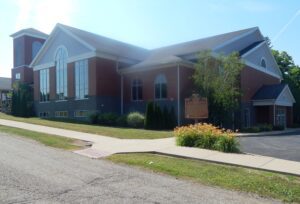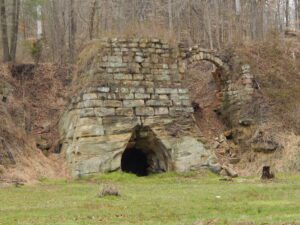, OH
Born on April 18, 1913, in Barrea, Province L’Aquila Abruzzi, Italy to Salvatore and Maria (Lombardozzi) Campana, Mary Ann Campana immigrated to the United States with her parents at age eight. Raised in Youngstown and educated in the Youngstown Public Schools and Youngstown College, Ms. Campana was a pioneer in Ohio, National, and international aviation. In 1932, at age eighteen, she achieved the distinction of being the first licensed woman pilot in Ohio. On June 4, 1933, with only 44 hours of prior flying time, Mary Ann established the world’s endurance record in the Light plane class for a non-refueled flight. Flying above Youngstown in a 500-pound Taylor Cub Plane with a 40-horsepower engine and loaded with 40 gallons of gasoline, she flew for 12 hours and 27 minutes without a parachute, breaking the old record by one hour and ten minutes before electrical storms forced her down. (Continued on other side)
, OH
On September 17, 1920, representatives from ten professional football teams met in Canton and formed the American Professional Football Association, which in 1922 became the National Football League (NFL). Pro football evolved from club football in the 1890s, and by the early 1900s had begun to spread across the country, concentrating in the Midwest. Jim Thorpe, the first nationally prominent pro, started with the Canton Bulldogs-an early pro football power-in 1915. In 1959, Canton citizens launched a well-organized and ultimately successful effort to have their city, “the cradle of professional football,” designated as the site of a monument to the sport’s historic stars. The Professional Football Hall of Fame opened on September 7, 1963, inducting seventeen charter members. The Hall of Fame interprets and promotes the study of the role of professional football in American culture.
, OH
The Friends Burying Grounds, once located here on Lot 17 in the Village of Damascus, is the oldest cemetery in Butler Township, Columbiana County. Expansion of the Friends Church necessitated the re-location of the Friends Burying Grounds. No markers were found to identify the graves of the 118 persons exhumed here. The exhumed remains were re-interred in the Damascus Cemetery on Valley Road, one block east of this location. The exhumation (2001-2002) was directed by Prof. Dr. John White of Youngstown State University, assisted by staff, students, and volunteers.
, OH
Olive Furnace in Lawrence County was one of 83 blast furnaces in the Hanging Rock iron-making region of southern Ohio and northern Kentucky. John Campbell (1808-1891), the “Father of Ironton,” and others established the furnace in 1846. The base of the furnace is carved out of rock and supported by Roman style arches. Only one of these arches remains some 170 years later. The furnace became a stop on the Underground Railroad. Conductors ushered escaping slaves through the area to points further north. The Olive Furnace was the last charcoal furnace to operate in Lawrence County. After seven decades of service, the furnace was sold and dismantled for scrap in 1915. Olive Furnace was listed on the National Register of Historic Places in 2007.
, OH
Abraham Lincoln and his family stopped in Steubenville on February 14, 1861 on their way to Lincoln’s presidential inauguration in Washington, D.C. Traveling by train, once in Steubenville he departed the depot to address a large crowd of Ohioans and Virginians from a platform at Market and High Streets. When Judge W.R. Lloyd introduced him as the only person who could preserve the Union during this time of national crisis, President elect Lincoln electrified the attentive audience by eloquently speaking on the commitment to the Constitution by people from both sides of the Ohio River, on the differing opinions of what the Constitution means, and on the virtues of majority rule. Fifty-seven days later, the Civil War began. No one at the time knew that Steubenville native Edwin M. Stanton would become Lincoln’s Secretary of War and that Stanton would give the immortal tribute at Lincoln’s death in 1865 saying, “Now he belongs to the ages!”
, OH
Archibald Worthington (1818-1895) was a freed slave from Virginia, a Civil War veteran, and prominent landowner in Highland Township. Census records indicate he was manumitted prior to 1850, and by 1860 owned land in northwest Ohio. Worthington also farmed, boarded freed slaves, and owned apple orchards and livestock. April 1866 township records show that he supported the local school for Black families. He and his wife Elizabeth raised three children: Henry, Mathilda, and James. Henry enlisted in the Massachusetts 54th Volunteer infantry, one of the first Black regiments formed in the Civil War. He died January 8, 1865, in a prison camp and is buried in North Carolina’s Salisbury National Cemetery. Mathilda and James both met partners and married, had children, and left the area. Archibald Worthington died in 1895 and is buried in Wilmington’s Sugar Grove Cemetery.
, OH
Golfing greats Arnold Palmer and Jack Nicklaus first met on the golf course at the Athens Country Club in Athens, Ohio. The event was a celebration for native son Dow Finsterwald, winner of the 1958 PGA Championship. Due to the significance of the event, Athens city officials proclaimed September 25, 1958, “Dow Finsterwald Day,” and the day featured an 18-hole exhibition golf match at the Athens Country Club. Reigning Masters Champion Arnold Palmer joined his long-time friend Finsterwald for the exhibition. Outstanding amateur Howard Baker Saunders of Gallipolis and eighteen year old Jack Nicklaus of Columbus completed the foursome. Nicklaus, a recent high school graduate, was a promising amateur with an Ohio State Open title and a national Jaycee championship to his credit. [Continued on other side]
, OH
Jonathan Wright (1782-1855) and his wife Mary Bateman Wright (1787-1866) moved with their five children from Menallen, Adams County, Pennsylvania, in 1814 and built this Federal style house. Using skills acquired from his father, Joel Wright, a surveyor who platted the city of Columbus, Jonathan platted the village of “Springborough,” named for the many springs in the vicinity. The Wright family established and operated a woolen factory, two flour mills, a general store, and a 320-acre farm in the Springboro area. The Wrights were active members of the Society of Friends (Quakers) and strongly opposed slavery. The house was a station on the Underground Railroad, offering assistance to runaway slaves during their flight to freedom. Many members of the Wright family, including Jonathan, Mary, and four of their children, are buried in the Friends Cemetery on nearby Factory Road.









